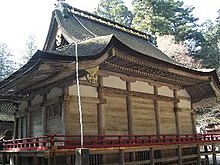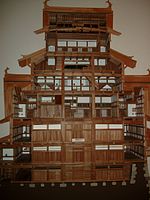Hiyoshi-zukuri

Hiyoshi-zukuri or hie-zukuri (日吉造), also called shōtei-zukuri / shōtai-zukuri (聖帝造) or sannō-zukuri (山王造) is a rare Shinto shrine architectural style presently found in only three instances, all at Hiyoshi Taisha in Ōtsu, Shiga, hence the name. They are the East and West Honden Hon-gū (本殿本宮) and the Sessha Usa Jingū Honden (摂社宇佐神宮本殿).
It is characterized by a hip-and gable roof with verandas called hisashi on the sides.[1] It has a hirairi structure, that is, the building has its main entrance on the side which runs parallel to the roof's ridge (non gabled-side).
The building is composed of a 3x2 ken[2] core called moya surrounded on three sides by a 1-ken wide hisashi, totaling 5x3 ken (see photo).[3] The three-sided hisashi is unique and typical of this style. The gabled roof extends in small porticos on the front and the two gabled sides.[4][1]The roof on the back has a characteristic shape (see photo below).

Notes
- ^ a b Iwanami Kōjien Japanese dictionary, 6th Edition (2008), DVD version
- ^ The ken is the distance between one supporting pillar and another, a quantity which can vary from shrine to shrine and even within the same building.
- ^ JAANUS, Hie-zukuri
- ^ History and Typology of Shrine Architecture, Encyclopedia of Shinto accessed on November 2009

